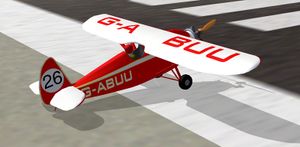Comper Swift
 | |
|---|---|
 | |
| Type | Sport aircraft, Historical aircraft |
| Configuration | High wing aircraft |
| Propulsion | Piston aircraft, Single-engine aircraft |
| Manufacturer | Comper |
| Author(s) | Lee Elliott |
| FDM | YASim |
| --aircraft= | ComperSwift |
| Status | Alpha |
| FDM |
|
| Systems |
|
| Cockpit |
|
| Model |
|
| Development | |
| Website |
|
| Repository |
|
| Download |
|
| License | GPLv2+ |
|
| |
The Comper C.L.A.7 Swift is a British 1930s single-seat sporting aircraft.
Aircraft help
Keyboard shortcuts
| Key | Function |
|---|---|
| K | Toggle trajectory markers |
| U | Update drop view position |
| [/] | Adjust view left/right (no flaps!) |
Manual
Flying Qualities
Without flaps, brakes or good forward visibility the Swift is a challenging aircraft to fly. When landing, you must lean your head out the side of the cockpit to see the runway. Add into this mix landing a tail dragger in a crosswind and you find it a challenge to land without ground looping or turning the aircraft over.
For a high performance aircraft, the Swift is very stable on its roll axis. The model does not show any significant dihedral, but it flys as if it does. It is a wing high monoplane, very modern for its time.
You will not need to refuel often and can go on long flights with its large capacity fuel tank.
Intended for racing, the flaps and brakes were left out to save weight or complexity. Flaps and brakes are not much use to an aircraft that spends most of its time circling the race course. Many racing aircraft lack forward visibility and place a pylon or part of the fuselage directly in front of the pilot. I can only speculate this may have been done on the Swift to make it more aerodynamic. My guess is the fuel tank capacity was designed for long duration races, circling the pylons for hours.
Takeoff
- No flaps to set
- No brakes to release (you might ask the attendant to remove the wheel chocks!)
- Throttle to full.
- Rotate
Landing
Landing is very challenging in the Swift. The pilot must lean their head out the side of the cockpit to see the runway. Position the aircraft so that the left or right side of the runway (depending on which side you are leaning) is barely visible along with some of the green next to the runway to land down the centerline.
- At the runway threshold, reduce throttle to idle.
- Do not flare. Fly the aircraft onto the runway. This is the best way to land in a tail dragger. If necessary, keep the throttle open a bit to maintain speed.
- Touch down with the front wheels first, holding the tail wheel off the ground until it settles and speed has bled off to reduce the chance for a ground loop.
It is very difficult to make a good landing crabbed into a crosswind while trying to keep aligned with the runway given the reduced forward visiblity. It is lots of fun to try and if you make it you will be happy.
Touchdown
Do not flare. Avoid floating the aircraft down on a cushion of air. The aircraft is likely to bounce. Do not be going too fast or you may bounce also. Fly the aircraft directly onto the runway in an even descent as if you were driving a car on the road.
Stay off the brakes (although the Swift does not have brakes, I am not sure they are disabled). In any event, if you brake too hard in a tail dragger you can turn it end over end. Or start a ground loop. Those are not the fun kind of loop you do in the air.
Leave the tail wheel up in the air. Touch down first on the front wheels. Push forward a little on the stick to force them down, but not too much or you will flip end to end.
Development status/Issues/Todo
Outside:
- Ailerons and pitch elevator would benefit from textures so that their shape are better recognisable
- The propeller lacks a texture (a simple wood material texture would be nice).
- No aircraft light available
3d Cockpit:
- Missing cockpit light at night (did original aircraft have one?)
- Missing rudder/stick control in 3d cockpit
- Missing rudder control pedals
- Missing switches and levers
- Missing elevator trim control
- Missing cockpit instruments
- Cockpit needs textures
- Cockpit needs pilot (for external cockpit view)
General:
- It is difficult to start the engines (I got it flying once, so I know they can start, unless something has broken).